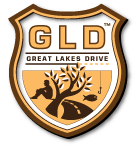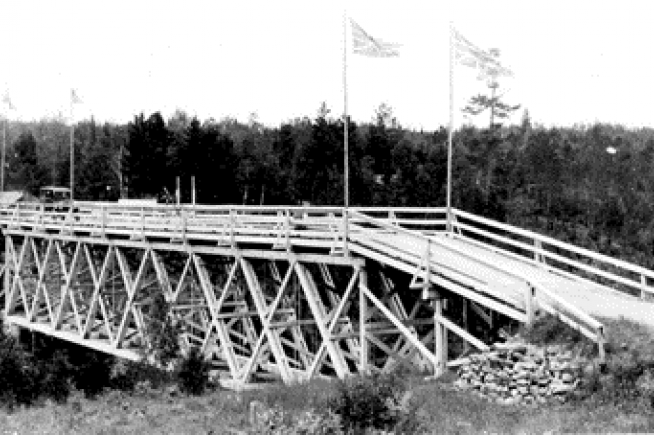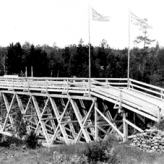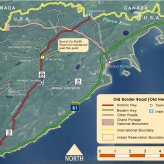Old Border Road (Old Hwy 61)
Old Border Road (Old Hwy 61)
Cannonball Bay, MN
For the past 50 years motorists traveling Highway 61 along the north shore of Lake Superior have crossed the border between the United States and Canada at a bridge over the Pigeon River. What many don’t know is that for nearly 50 years the border crossing lay 15 miles inland at a different place also called “Pigeon River”. Today that old border crossing is closed, but the highway that once traveled 13 miles inland to reach it is still around, tempting highway buffs to travel its crumbling pavement through tall pines and birch trees, navigating around its hair-pin turns and steep hills.
History
The old border crossing first came into use in 1917 after local rotary groups on both sides of the border decided to build a bridge over the Pigeon River as part of a road between Duluth and Port Arthur (now Thunder Bay) in Ontario. The locals had become sick of waiting for approval from the U.S. and Canadian governments, which was required for any permanent crossing per treaty. The bridge therefore became known as the “Outlaw Bridge” because of its less than legal origins.
The “Outlaw Bridge” had its grand opening in August of 1917. It ended on each side with steep ramps due to a shortage of materials. Small communities sprouted up on both sides of the bridge to cater to tourists, featuring small hotels, restaurants, and service stations, as well as the obligatory customs and immigration stations.
In early 1921 the road leading inland to the bridge was taken over by the state and became part of Trunk Highway Number 1, which later became part part of U.S. Highway 61 in late 1926. In 1930 the original wooden bridge was replaced by a modern iron truss span. In addition, the final stretch of the road leading to the bridge was widened and straightened.
During the 1920’s and 1930’s, the local Chippewa on the Grand Portage Indian Reservation began to take advantage of the burgeoning tourist trade on the new highway between Duluth and Canada, opening restaurants, cabins, and souvenir stores. However, the main community at Grand Portage was located more than four miles east of the original Duluth-Port Arthur Highway. A dead-end road led east from the highway at Mineral Center to the town. The reservation council did not want Grand Portage to be “located at any dead-end street” (the words of the council’s attorney).
By 1935 the Highway Department had acquired approval from both the Canadian government and the Chippewa to acquire a right-of-way for a new highway that would more closely follow the shore of Lake Superior and pass through the community of Grand Portage. However, an opposing coalition of conservation groups and the Department of the Interior banded together to block it, believing that the real beneficiaries of the new highway would be white land and business owners in Duluth and Grand Marais. They also sought to preserve the Chippewa’s way of life.
Initially, the Federal Government blocked the condemnation procedures on the grounds that the Indian lands on the proposed right-of-way were held in trust by the federal government, and since the United States could not be sued for condemnation without an act of congress, the state could not proceed without permission from the Secretary of the Interior. The case made it all the way to the Supreme Court, where a decision was made on January 3, 1939, finding for the United States. With its plans blocked, the Highway Department decided to finally pave the old border road as a temporary measure. When the paving was completed later in 1939, the old border road became the final piece of the north shore highway to be paved.
Although congress eventually authorized the condemnation of the right-of-way for the proposed north shore highway in 1942, construction was delayed for nearly 20 years by World War 2 and by other high priority post-war projects. Construction finally began in 1958, and the new border crossing was completed by the end of 1963. However, the new highway only reached as far south as Mineral Center Road, just south of Grand Portage. Mineral Center Road was taken over as a temporary connection between the new and old roads until the southern stretch could be completed. The rest of the new highway was finally opened on August 9, 1966. The old border road reverted to local control, and the old bridge was removed.
The February 1961 edition of “Minnesota Highways” (the employee newsletter of the MHD) featured the following poem by Milon Peterson about the old border road, dedicated to his friend Ray Olson who had maintained it for 35 years.
It’s always dark up on Ray’s beat.
Yes, the sun never shines up at Mineral Center.
You will find rain, snow, fog or sleet,
When you enter that narrow road.
Thirteen miles to its torturous end,
It twists and turns in an anguished climb.
You must stalk each hill, each murderous bend,
As you travel the narrow road.
The surveyors must have followed a footloose moose,
Or perhaps some fox, or a wondering deer.
Surely full of despair and a fermented juice.
When they laid the narrow road.
So in the cold gray dawn we fill our load,
Of sand, and salt and chloride too.
And head east to the wilds of no abode,
To a never ending task on the narrow road.
Read more at link below…
Great Article and more interesting historic information about MN roads and locations can be found at www.deadpioneer.com
Old Border Road (Old Hwy 61) Article
Content the property of www.deadpioneer.com.




